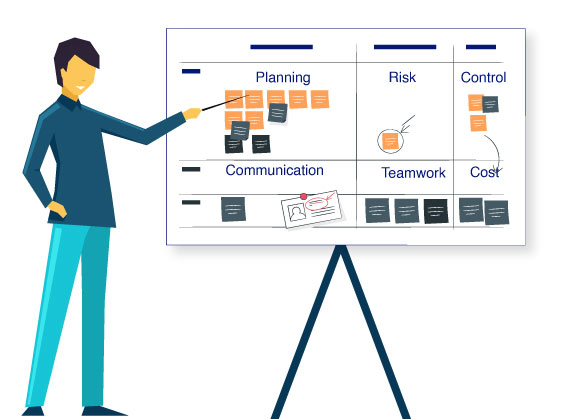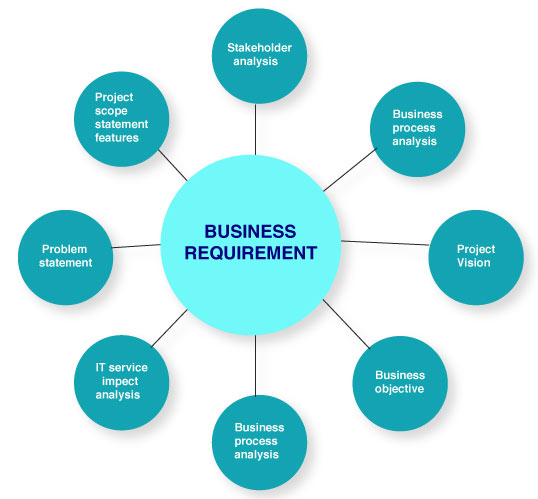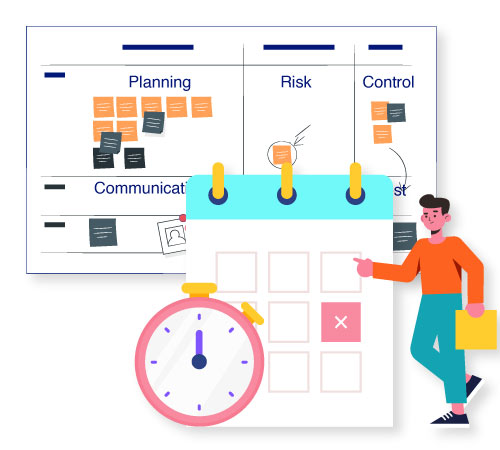What is Project Planning in Project Management | Step-By-Step Guide
Project Management is an often adopted method that helps organizations finish their tasks with a high success rate. It is the method used by project managers that involve strategies, skills, and tools required to complete the project.
There are six things that one should consider when managing a project. They are as follows:
- Scope
- Time
- Quality
- Cost
- Risk
- Resources
To take all these things into considerations throughout a project’s lifecycle, a project manager takes certain steps. These steps involve initiation, planning, execution, controlling, and closure.
Among these steps, project planning is one of the most important. The project manager carries out the entire project planning and management using the tools available and considering the project’s constraints.
This article will discuss the project planning step to know more about what goes on in making any project a success and how PeppyBiz helps its customers achieve their targets.
What is Project Planning?

Project planning is the process of telling your team what they have to do and how they have to do it. This involves documentation that describes the costs, the order of events, communication with clients, schedules, and risks. This phase in project management also defines the project deliverables and requirements.
Project planning and management also help control the staff and suppliers to keep the constraints in check at all times. This phase of project management is one of the hardest and most challenging since it must cover everything in a project from this point forward.
This phase is the refinement of the initiation phase since it defines the specific activities and resources for completing the project. Know the different project management methodologies and how PeppyBiz project management software can help you achieve your project management goals here.
Purpose of Project Planning
1. Set up business requirements:

You must define all business-related resources needed to complete the project. This way, you can avoid or identify problems that might occur in the future.
2. Set up cost:

For any project maintaining the budget is of utmost importance. A project plan must list all the processes to reduce any wastage of resources that might lead to discrepancies in the budget.
3. Set up a schedule:

A project planning must contain the time constraints for each project’s task. Assigning deadlines for each task reduces the risk of overdue projects and motivates them to complete the project on time.
4. Set up a list of deliverables:
The project planning and management must include all deliverables for a project. This enables the checking of whether all the products are ready for delivery or not.
5. Set up delivery dates:

Delivering all the products of a complex project on the same day is rarely possible. That is why it is critical for the project planning to consider specific delivery dates for each product of the project.
6. Set up resource management plans:
This is a vital and a must-have aspect in project planning and management. It must take into account the number of resources used and specify the way it’s used.
7. Get approval for all the above:
This is the most challenging part of the project planning phase. The management must agree on all the listed processes to further carry on with the project management steps.
The above-listed points are the primary purpose of project planning. All these qualities are important to create a well-prepared project plan document. PeppyBiz can provide you with all the services needed to perfectly execute your project.
Approaches to Project Planning
There are two globally used ways of identifying the components of a project.
- Planning by incentive: This method is often adopted because it focuses on the deliverables. The project planning points out how to achieve the deliverables using the intermediate process required to meet the result.
- Planning by direction: This method emphasizes the types of activities needed to produce the desired outcome. This project planning method also points out the type and amount of resources required for the project.
To know more about the various methodologies and steps involved in project planning and management, visit PeppyBiz’s knowledge base to learn more about the exclusive services and tools available.
Steps to Achieve an Effective Project Plan
The project planning and management process is a high-level managerial task and a long one. But with some simple steps laid down by experts, it is possible to create powerful project planning for your project.
Step 1: Identify the goal of the project
The first step to planning a project is identifying what the project’s ultimate goal will be after completion. For this purpose, you must establish strong communication with your customer. Communicating with the customer enables you to focus on what’s important for that specific project. This also makes it easy for the project leader to explain the task and the team’s ultimate goal.
Step 2: Establish a mission statement.
For a successful project planning process, it is critical to creating a mission statement that outlines the path and development of the project. This will serve as a guide to your team, and every member should effectively comprehend the statement.
Step 3: Develop a strategy for the project
This step illustrates the implementation of the project objectives. During this step of the project planning process, you can conduct a Feasibility study on your plan to make sure that the project is workable. This strategy plan created must describe the project’s work, the tasks undertaken by each team member, and how to achieve the goal.
Step 4: Establish a scope statement.
Setting up a mission statement and a scope statement might sound the same, but the latter adds a little more to the former. The scope of a project planning process focuses on the boundaries within which the project must operate. This enables the setting up of obvious limitations to the project work and the extent of the aim.
Step 5: Work Breakdown Structure (WBS)
This is an important aspect of the project planning and management process. In any project, there are lots of minuscule tasks involved to achieve the result. This step must outline the project’s dependencies and point out the time allotted, the resource needed, and cost estimates. The cost estimates here aren’t the total cost estimates but the cost required to carry out each small task.
A typical example of a Work Breakdown Structure(WBS)
Step 6: Develop a project schedule.
In this step of project planning, you should develop a timetable that shows the time duration allotted for the WBS individual tasks. You must also include the collective time taken for the completion of the entire project. This step in project planning also includes information about resource assignments, each team member’s specific tasks, and time duration for each task.
For efficient organization and management, consider utilizing a digital planner for iPad to streamline task allocation, scheduling, and collaboration.
Step 7: Prepare a budget sheet.
After all these steps mentioned above, it is time to estimate the costs and prepare a budget sheet for the project work. This document requires communication with the sales team and the customer to make the budget sheet.
A budget sheet template
Step 8: Create the project organization structure
This is one of the most critical steps in the project planning process. This step requires you to determine the employee-specific job responsibilities and implementation. The organization provides a set of policies on how things work. These define the team’s functional operations in the project.
Step 9: Establish a primary tool for communication
A well-united team is necessary for the project’s success. Proper communication can enable team members to collaborate and work well. The implementation of WBS becomes easier because of this. Providing tools such as project management software serves as effective communication channels.
Step 10: Creating a general plan
The general plan in project planning is the final step. Here you will include all the tools, solutions, and decisions identified in the previous steps. The general plan also includes subsidiary plans as redundant and also lists how to manage identified risks.
To streamline this process, you can utilize schedule planner app, which offer structured formats to organize your project details efficiently.
Best Project Management Software
Now you might be wondering, is there anything that can make this process easy? Yes, there is! There are lots of free project management software that are capable of performing a variety of tasks. Almost every organization worldwide has some kind of project management software to help them ease project planning and management.
The following are the key aspects of project management software.
- Organizing steps of a project
- Scheduling of tasks
- Sharing of project data
- Communication with the team members
- Monitoring, control, and reporting
A project management software can be a huge advantage for an organization since it reduces the time taken to manually assign the task to the team members. Thus making the task of planning and executing an easier one. Take a look at the list of the best project management software for 2021 listed by PeppyBiz and choose wisely.
Conclusion
To summarize, project planning is a hefty task that needs careful preparation. On successful implementation, all the team members will be able to foresee problems before they happen. Thus proper project planning and management help create a positive environment that boosts productivity.
Selecting the best project management tool can ensure a boost in productivity. PeppyBiz provides project management solutions and tools to help develop and analyze the customers and grow your business rapidly with the simplest solutions.



